| |
"You see that crap? All that horror crap? Things coming out of crates and eating people? Dead people coming back to life? People turning into weeds, for Christ's sake?" |
| |
Concerned father Stan to his wife after throwing away his son
Billy's horror comic, providing a brief preview of things to come |
| |
"The most fun you'll ever have being scared." |
| |
Original tagline for Creepshow |
I recently realised that every time I've reviewed an anthology horror film I've opened by musing how difficult it is to get such things right. I also realise that by bringing that up, I've effectively done the exact same thing here, damn it. Consistency has always been an issue with such films and that's hardly surprising, given that you'll also be lucky to find four or five consecutive features made by the same director that are of uniform quality. So just for the hell of it, let's split these movies into two distinct categories, those in which the individual stories are handled by different writers and/or directors, and those where the same writer and director are responsible for the whole thing. In theory, films that fall into that second group should be more consistent in content and style than those in the first, but it doesn't always work out that way.
In the mid-to-late 1960s and early 70s, British film company Amicus made the format their own the likes of Dr. Terror's House of Horrors, Vault of Horror, Tales From the Crypt, Asylum, The House That Dripped Blood and Torture Garden, all of which did solid box-office business. Yet despite the fact that each of these films had a single screenwriter and director, only Tales From the Crypt and Vault of Horror have the consistency of quality we're looking for here. That the stories in both were direct adaptations of ones that had been published in the identically titled E.C. Horror Comics of the early 50s is surely no coincidence.

Horror anthologies have come and gone since and the quality of the individual components have continued to vary. Then in 1982, a new one appeared that nailed the format better than any film since Tales From the Crypt had done ten years earlier. And what do you know, once again those E.C. Horror Comics were the driving force behind the project, though this time they were the inspiration for five new tales rather than the source material for screen adaptations. And they were written and directed by people with a passion for these comics and the collective skill to bring them to life on screen. Ladies and gentlemen, welcome to Creepshow, five diabolical tales of comic book horror created by two giants of the genre, author Stephen King and director George A. Romero.
The two establish their intentions with gleeful aplomb in the pre-title prologue, as a crash of thunder accompanied by a portentous piano theme jump cuts in on a Halloween pumpkin sitting on the porch of a house in which a father is in the process of balling out his young son Billy for owning a horror comic. "I told you before I didn't want you to read this crap," he tells him. "I never saw such rotten crap in my life. Where do get this shit?" Billy cannot see how his comic is any worse than the sex books that he knows his father reads, a response that earns him a slap round the face. As the father throws the book in the trash and settles down for a beer, proud of his evening's work, he reminds his more apprehensive wife, "that's why God made father's, babe." Cut to Billy's bedroom, which is adorned with the sort of horror memorabilia that many a dedicated genre fan had in their room as a kid, and Billy has a look of determined hatred on his face. "I hope you rot in hell," he angrily spits. Then, as the music and outside storm build, his attention is caught by something at the window, a raggedly dressed and beckoning ghoul with a rotting face and a skeletal grin. Is Billy frightened? Is he hell. He smiles with almost ecstatic delight and slaps his fist into his hand with the unfettered glee of a boy whose every dream has suddenly been realised. It's a sequence made by horror comic fans and targeted at the like-minded, and every time I watch it my heart sings with joy.
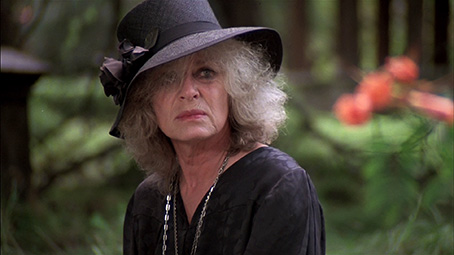
The comic book itself (drawn by former E.C. Horror Comics artist Jack Kamen) provides the foundation for the animated titles and becomes the glue that links the five stories that follow. Its pages are fluttered and turned by the wind and land on the first panel of the tale that is about to unfold, which dissolves into the identically framed opening shot of the live action story. In Father's Day, members of the Grantham family gather to mark the anniversary of the death of the family's ancient and insufferable patriarch Nathan, who was killed by his daughter Bedelia in a fit of frustrated rage. But Nathan is still owed that father's day cake he was screaming for when Bedelia delivered the fatal blow. In The Lonesome Death of Jordy Verrill, a meteor crash lands on the farm of a country hick who sees moneymaking potential in selling the rock to the local university, but his plans are scuppered when he becomes infected by the meteor's organic contents. In Something to Tide You Over, wealthy businessman Richard Vickers discovers that his young wife Becky has been having an affair with good-looking TV presenter Harry, and plans a particularly unpleasant fate for the two. In The Crate, the discovery of a long hidden wooden container from a nineteenth century Arctic exhibition has lethal consequences, but presents henpecked husband Henry Northrup with a golden opportunity to escape his miserable home life. And in They're Creeping Up on You, spiteful business magnete Upson Pratt finds his supposedly germ-free sealed apartment gradually overrun by cockroaches.
The stories in E.C. Horror Comics had a distinctive style. Usually brief and simple in structure, they were largely morality tales in which the wicked and greedy paid the price for their actions, often at the hands of those they had wronged. And in horror comics, killing someone wouldn't prevent them from coming back from the dead and dishing out an appropriately themed punishment. Sometimes events sent the central character on the road to madness or inadvertently brought about their own death or downfall, and many of the tales concluded with a satisfying sting.
All of the stories here could have been lifted straight from the original comics (even the titles are authentic), so closely do they emulate their style and structure, but they have the added bonus of King's way with character and ear for dialogue. He also gives each story a very distinct identity: Father's Day is an old school E.C. grisly revenge tale; The Lonesome Death of Jordy Verrill is a story of inadvertently self-inflicted downfall (signalled by a title that makes no bones about the fate awaiting the title character); Something to Tide You Over sees a malicious revenge turned around on its perpetrator; The Crate is a small scale monster movie where unhappiness drives an ordinary man to commit a seemingly unspeakable act; and They're Creeping Up on You is a straight-up political allegory dressed in horror clothing.
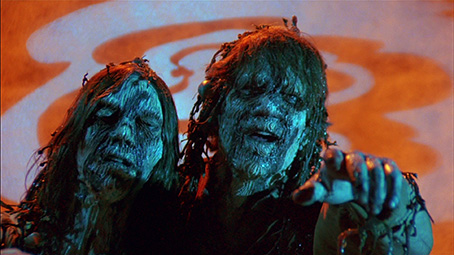
Romero also takes his cue from the E.C. Comics in his visual interpretation, using comic book frames for scene transitions and flashbacks, sudden switches to bright, prime coloured lighting when events take a dramatic turn, and hand-crafted "shock" background graphics in climactic moments of horror. It's a risky strategy, but is so sublimely blended with the live action drama (it helps that the comic book structure is so clearly established at an early stage and used to link the stories) that it's hard to imagine the film without them.
This was post-Martin and post-Dawn of the Dead Romero in full command of his skills as a visual storyteller. Remarkably, he not only appears to have had no trouble adapting to the short film format (how many fine directors have fallen on their face when asked to do likewise?), but seems to relish it, creating five short films in which characters are clearly defined in the minimum of screen time and whose stories unfold in gripping and consistently entertaining fashion. King's witty and tightly structured screenplay provides the foundations, on which Romero builds with the energy and invention of a first-timer given the money and freedom to have a cinematic blast. It's gorgeously shot by Romero regular Michael Gornick, who gives each of the tales its own specific look and colour palette (much like the stories in the original horror comics, each of which were drawn by a different artist) but maintains a degree of continuity that ensures that they still all feel very much part of the same film. It's a similar story with Jon Harrison's score, a fabulous blend of tinkling piano riffs, stabbed single notes and chords, electronic strings and ominous synthesiser drones that give each of the stories a very specific musical identity, but always feel part of a cohesive whole. That the editing is scalpel-sharp and purposeful throughout will come as no surprise given the quality of work on Romero's Martin, The Crazies and Dawn of the Dead, but here the five stories were handled by four different editors – including Romero regular Pasquale Buba, Star Wars editor Paul Hirsch, and Romero himself, while Father's Day and They're Creeping Up on You were both cut by Michael Spolan – with no major variance in style or continuity. I should also give a serious shout for Cletus Anderson's art direction, which delivers vividly suggestive sets on a minimal budget, peaking in his arresting organic transformation of the isolated house in The Lonesome Death of Jordy Verrill.
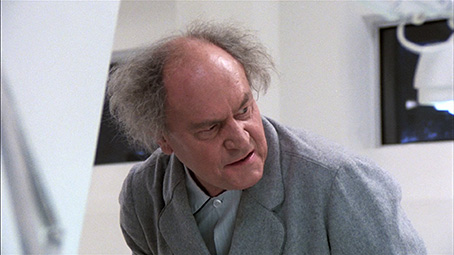
But the icing on the cake here just has to be the casting. Rather than plump for unknowns or enthusiastic newcomers, Romero aimed high and landed what has to rank as his most star-studded cast to date (although it's worth noting that a couple of the key cast members here were on the brink of the fame they were later to achieve). And there isn't an actor here who doesn't completely commit to what many would doubtless have dismissed as somehow unworthy of their talents (do me a favour). You'll find no better example of this than the first story, Father's Day, where characters are established in their first line of dialogue, from Warner Shook's camp weariness as brother Richard to Carrie Nye's hilariously mannered turn as the regal Aunt Sylvia, while veteran Swedish actress Viveca Lindfors is a joy as the dotty but still angrily resentful Aunt Bedelia. And yes, that's a young and fresh-faced Ed Harris in the role of Cassie's not-too-comfortable boyfriend Hank.
Romero scores similar casting coups elsewhere. Something to Tide You Over pits a young pre-Cheers Ted Danson against a pre-Airplane Leslie Nielson, who delivers one of the film's most impressive performances as the vindictive Richard, moving seamlessly from deceptively cheerful clowning to sinister threats and back in the space of a single exchange, and even pulling off brink-of-madness hysteria without overstepping the line. The Crate has veteran actors Fritz Weaver and Hal Holbrook as the flirty Professor Dexter Stanley and henpecked husband Henry Northrup, and Adrienne Barbeau comes close to stealing the film as Henry's loudly insufferable wife Wilma. Quite how Romero landed veteran character actor E.G. Marshall for They're Creeping Up on You is anybody's guess, but he runs with the role, relishing Upson Pratt's amoral nastiness and the creativity of his swearing: "I've got to let you go George," he tells one of his long-suffering subordinates by phone. "You did well. Go out and fuck somebody. But wear a damned rubber. Everyone's got the damned herpes these days." The only performance that has divided commentators is that of Stephen King himself as Jordy Verrill. It's a turn that gives new meaning to the term "larger than life", apparently the result of Romero encouraging him to play the role in the manner of Wile E. Coyote from the Road Runner cartoons, something Romero claims that King has never forgiven him for. But it absolutely works for a story that starts in comical fashion and gradually descends into darkness, and we end up feeling more for Jordy Verrill's fate than that of any other in the film. And in case you didn't know, the boy who plays Billy with such delightful relish in the opening and closing scenes is none other that Stephen King's then young son Joe.
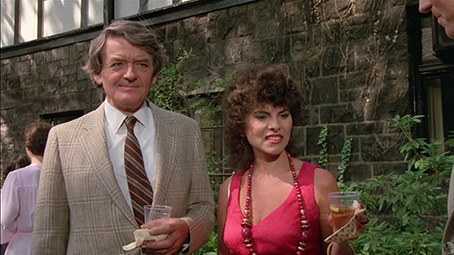
This blend of script, performance, invention, energy and technical polish not only made Creepshow the American horror highlight of 1982, but gives it almost endless replay value, the entertainment coming less from wondering where the stories will go next than the specifics of the journey and the frequently thrilling manner in which these elements are combined. We might question the misogynous undertone of The Crate (to say more would act as a plot spoiler to newcomers), but we are in the world of 50s horror comics here, and the story itself has a direct antecedent in the tale Indisposed from issue 25 of The Haunt of Fear. And Romero and his collaborators are not just having fun here – there are sequences in The Crate as tense as any in more serious minded horror features of the period, and the revolutionary politics underlying They're Creeping Up on You have all the bite and social relevance of the Dawn of the Dead's celebrated anti-consumerist message. Beating even Tales From the Crypt into second place as the best comic-inspired anthology horror film, Creepshow has stood the test of time wonderfully and to this day remains more genuine fun than any other horror film I can readily recall.
Hell, just for once, the tagline was telling the truth.
My hopes were high for this one and the transfer here lives up to and in some ways surpasses my expectations. For the most part Creepshow looks terrific on Blu-ray, with a fabulously crisp image, spot-on contrast, solid black levels and a lovely reproduction of the film's sometimes vivid colour palette. The greens of the vegetation in The Lonesome Death of Jordy Verrill and the reds and blues of the shock moment lighting are particularly well captured, as are the more natural hues of the daylight material. A surprising number of dust spots still remain, though they are more visible on areas of single colour (the clear blue sky of Something to Tide You Over and the white apartment of They're Creeping Up on You), and there is a little banding in the sky in the opening (process) shot of Jordy Verrill, but in all other respects this is a lovely job that leaves the previous DVD standing. As with a few too many HD transfers of late, the original 1.85:1 framing appears to have been slightly cropped at the edges to fill the 16:9 frame.
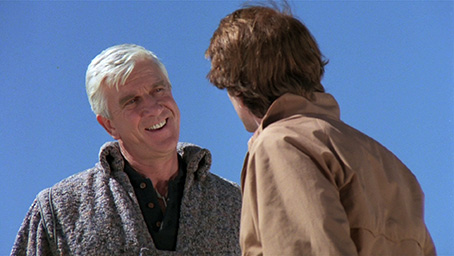
Soundtrack-wise, there's a choice between Linear PCM stereo 2.0 and DTS-HD 5.1 surround. Both are clear and boast a strong reproduction of John Harrison's score, but on the 5.1 the music and effects are more widely spread and have a slightly richer feel. The balance between effects, music and dialogue feels better on the stereo track, however.
Surprisingly, there are no subtitle options.
Several of the extra features on this new Second Sight Blu-ray have been ported over from the 2-disc special edition DVD that was released in the UK by Universal back in 2007. Given the quality of this material this is no bad thing, and the documentary Just Desserts has been remastered in HD for this release.
Audio Commentary with Director George Romero and Special Make-up Effects Creator Tom Savini
An unsurprisingly lively commentary, given that the two are old friends and regular collaborators and both are cheerful enthusiasts for their craft. The commentary is actually moderated by Michael Felsher, the driving force behind all of the extra features here, and while I salute his work elsewhere he's not much of a feed man on this track – there are a couple of times when he allows the two to wander and really needed to nudge them to get them back on track. For the most part, though, this is a great deal of fun and is bristling with interesting and entertaining stories. Detail is provided on the locations and sets and some of the technical tricks employed (it may not look it, but Creepshow was a low-budget film and almost all of the effects were done in-camera), and there is a lot of appreciation for the work of the actors, particularly Leslie Nielson, although this is not the only place you'll here stories of him and his fart machine. At one point Savini remembers that the track is for a British disc and switches a previously generic put-down to "He's a wanker."
Audio Commentary with Director of Photography Michael Gornick, Actor John Amplas, Property Master Bruce Alan Miller and Makeup Effects Assistant Darryl Ferrucci
A commentary track that is new to this edition that's not actually a commentary in the usual sense, being made up of new interview material recorded by Michael Felsher to supplement the interviews he secured for the documentary Just Desserts. And interviews they are, conducted as they would be for a second documentary and not remotely specific to what is happening on screen. But having griped about Felsher's performance as a feed man on the commentary above, I'll happily retract that for his enthusiasm here. Michael Gornick describes working on the film as "a glorious event" and recalls the process of shooting various key scenes, working with actors, and his experiences on the cockroach set (almost everyone is asked about these last two). Bruce Alan Miller describes assisting Cletus Anderson and particularly creating props and set dressing the Jordy Verrill set; he has more stories about the cockroach shoot, and is the only person on this particular extra to mention Leslie Nielson’s fart machine. Darryl Ferrucci recalls how he first became Tom Savini's assistant (this is rather good), playing the crate monster 'Fluffy' and the transformed Jordy Verrill, and what he's done since. Oh, and what it was like working with so many cockroaches. The ever-amiable John Amplas talks about his small but significant role as the resurrected Nathan, working with other actors, and the one bit of his role that he chickened out of doing. There's also a small bit of Felsher's chat with comic book artist Bernie Wrightson that didn't make it into Just Desserts, where he recalls how he first landed the job of drawing the tie-in comic. Felsher completes something left incomplete in the earlier commentary by identifying where a signature ashtray appears in each of the stories.

Just Desserts: The Making of Creepshow (89:30)
Michael Felsher's retrospective making-of documentary from the 2-disc DVD, here remastered in high definition, is a most worthwhile inclusion, being an enormously enjoyable and detailed piece. It's built around interviews with cast and crew members and kicks off by looking at E.C. Horror Comics and how the film came about, then breaks down the production into specifically themed chapters: Acting Scared (the cast); A Comic Book World (the visualisation); The Monster Man (Savini and his make-up effects); Creepy Crawlies (procuring and working with thousands of cockroaches); Anthology Unleashed (animation, music and audience reaction); and 25 Years Later, where the interviewees look back at the film and how they feel it stands up. As expected, Romero himself proves a most engaging raconteur, but there are plenty of revealing contributions here, from Savini's admission that the makeup effects crew consisted of just himself and a single 17-year-old trainee, to Romero's claim that until this film he had never even heard of Foley recording. Perhaps the most startling revelation for me was that at the time the film was made, score composer John Harrison wasn't a professional musician but the film's first assistant director – Romero was originally looking to score the film with library music, and the musically minded Harrison suggested that maybe he could have a go at writing the score. Say, what? I was also delighted to learn that one of the most memorable themes – one that plays after Richard has left Harry at the beach in Something to Tide You Over, was the result of Romero suggesting a piece that blended a metronome beat with The Camptown Races. It's a shame Felsher was not able to persuade Stephen King to take part, but I was impressed he managed to land a chat with Ed Harris.
Behind the Screams with Tom Savini (26:29)
Low-band video footage of Savini's make-up effects work on the film, the details of which I can't really list without delivering a string of spoilers for newcomers to the film, but it does include footage of both Stephen King and Ted Danson in the make-up chair, and some neat test footage of a creature known on the set as 'Fluffy'. As this is low resolution, it's been windowboxed in a comic book frame here.
Deleted Scenes (15:20)
A number of deleted scenes from all five stories, edited and scored but drawn from low-band video, so these have again been windowboxed in a comic book frame. Valuable material for fans of the film, some of it does over-emphasise plot points that work far better as they stand now, but it does include the uncensored version of Adrienne Barbeau's use of a particularly strong swear word in The Crate.
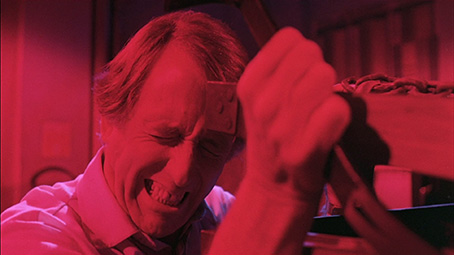
Theatrical Trailer (1:29)
The most fun you'll ever have being scared! Not too shabby, and does include footage from one of the deleted scenes, but also has a couple of spoilers.
Original TV Spot (0:26)
A severely cut down version of the above that ends with a cheery "Now playing at a theatre near you!"
Stills Galleries
16 rolling stills galleries, covering everything from artwork and posters to pressbooks, lobby cards and video and DVD covers. Most are quite short, though Behind the Scenes, Lobby Cards and Special FX Bits run for over 3 minutes each. The images move rather speedily along, but can be paused for closer examination. The Screenplay one is a bit of let-down, being 6 seconds long and consisting to two photos of the script's front page.
Objectivity be damned, this is my all-time favourite horror anthology and a film that still fills me with glee on every viewing. Everything works here, from the writing and direction to the performances, set design, photography and music. And it's never looked better than it does on this new Second Sight Blu-ray, which includes all of the extras from the previous Universal 2-disc DVD and more. Love it. Highly recommended.
|